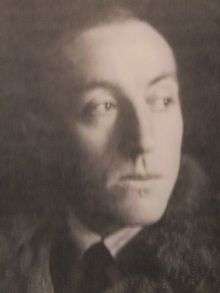Edwin Scharff
| Olympic medalist | ||
 Edwin Scharff | ||
| Medal record | ||
| Art competitions | ||
|---|---|---|
| | 1928 Amsterdam | Sculpture Medals |
Edwin Scharff (March 21, 1887 – May 18, 1955) was a German sculptor. He was born in Neu-Ulm and died in Hamburg.[1]

Biography
Scharff attended the Kunstgewerbeschule (1902–3) in Munich and studied painting at the Akademie der Bildenden Künste from 1904 to 1907. He lived in Paris between 1912 and 1913, where he was influenced by the work of Aristide Maillol and Auguste Rodin. After serving in the German army during World War One, where he was badly wounded, he became a professor of sculpture at the Vereinigte Staatsschulen für Freie und Angewandte Kunst, Berlin (1923). He was removed by the Nazis in 1933, after which he found a position at the Kunstakademie in Düsseldorf (1934–1937).[1]
In 1928 he won a bronze medal in the art competitions of the Olympic Games for his "Médaille pour les Jeux Olympiques" ("Olympic medals"). For the Reich's Exhibition of 1937 in Düsseldorf he produced two large equestrian statues for the fair's portals, which resulted in Scharff being classified as a degenerate artist. He continued to work in secret during World War Two, and after the war he became a professor at the Landeskunstschule in Hamburg.[1]
Legacy
In 1955, the city of Hamburg created Edwin Scharff Prize, which is awarded annually to an artist that has influenced the cultural life of the city.[2]
References
- 1 2 3 Jörgens-lendrum, Helga (2013), "Scharff, Edwin", Grove Art Online. Oxford Art Online: 14, retrieved 2013-12-14
- ↑ "Edwin-Scharff-Preis". hamburg.de. Retrieved 14 December 2013.
External links
| Wikimedia Commons has media related to Edwin Scharff. |
- Artist homepage (German)
- Scharff museum (German)
- dataOlympics profile
- Drawings in the collection of the Los Angeles County Museum of Art